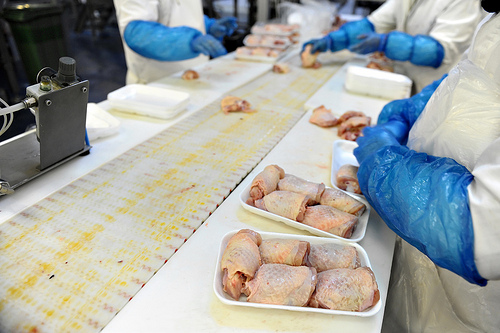



Our Race Against Bacteria: Linking Livestock Production and Human Medicine
GLOBAL - The last decade has seen veterinary authorities address the routine use of antimicrobial drugs and prescribe more judicious use. But how could this benefit human health, and what are the risks if it does not?- This second article in the series explores the policy adaptations of the World Health Organisation (WHO) and the World Organisation for Animal Health (OIE).
- The most important drugs to medicine are outlined, as is the danger of not having success in preserving them.
The Risks of Resistance
A human with a resistant infection will remain ill longer, have a greater risk of death and cost more money to treat, whilst increasing the risk of spreading the infection.
*
"Antibiotics are losing their effectiveness at a rate that is both alarming and irreversible - similar to global warming.”
The concern from the livestock sector is that the development of resistant pathogens in pig and poultry units will impact human health.
This pressures livestock sectors, jeopardising food security as farm mortality rates rise. Considerable yield losses risk being incurred if a pig dies of infections before reaching slaughter weight, cows succumb to disease mid-lactation and laying birds die before leading a fully productive life.
The threat of antimicrobial resistance has been likened to that of global warming and terrorism by Professor Dame Sally Davies, Chief Medical Officer for England.
This concern was reflected on the global stage in 2013 when politicians put AMR firmly in the limelight when it made the agenda at the G8 summit.
G8 Science Ministers released a statement promising collaborative action to, ‘preserve the efficacy of existing microbial agents, in part by avoiding misuse and optimising prescribing practices in our respective countries.’
What has been done?
Policy makers and health experts are now rolling out national health plans to promote more responsible use of antimicrobial medicines prescribed to combat disease in both humans and animals. Part of the philosophy is that preventing infections is more sustainable than curing infections with antibiotics.
Antibiotic ‘misuse’ was underlined at a global level in 2001, when the WHO linked AMR with the ‘inappropriate use’ of antibiotics e.g. prescribing shortened courses of treatment or sub-optimal doses.
*
"When the decision is reached to use antimicrobials for therapy, veterinarians should strive to optimize therapeutic efficacy and minimize resistance to antimicrobials to protect public and animal health."
In 2003, an expert panel comprising the World Food and Agriculture Organisation (FAO), World Organisation for Animal Health (OIE) and World Health Organisation recommended that the WHO and OIE develop a list of critically important antimicrobial medicines for humans and animals respectively.
The WHO list for humans was officially released in 2007, and is regularly updated to ensure that modern medicine’s most effective treatments remained available for as long as possible.
The ‘critically important’ drugs are split into the following classes.
• Quinolones
• 3rd and 4th generation cephalosporins
• Macrolides
• Glycopeptides
The drugs on the critical list include drugs pertinent to both human and animal medicine. But, while the drugs and the microbes they treat have similarities across humans and animal species, the effect that livestock production is having on human antimicrobial resistance and infection commands great debate.
Linking Humans and Animals
The transfer of disease between humans and another species is known as zoonosis. Two leading resistant zoonotic pathogens are Campylobacter and Salmonella.
There is disagreement over how much contamination arises in humans from bacteria from livestock environments. However, the consensus is that there is potential for cross over.
Samples from humans in 2010 showed Salmonella resistance to ampicillin, tetracyclines and sulphonamides was high.
The impact of this is not as great as resistance to cefotaxime (a third-generation cephalosporin) and ciprofloxacin (a flouraquinalone), both classed as critically important, which were reported as having ‘relatively low’ resistance.
The findings appeared in a European Food Safety Authority (EFSA) journal article in 2010 which summarised resistance of indicator bacteria from humans, animals and food. This meant a focus around E.Coli, Salmonella and Campylobacter bacteria.
The report provided figures to show how poultry production was the main source of resistant bacteria.
Over a quarter (28 per cent) of Salmonella isolates in Turkeys and 24 per cent in broiler chickens were found to be resistant to ciprofloxacin. Resistance of E.coli isolates was reported as 29 per cent in broilers and 2 per cent in pigs.
Widespread campylobacter resistance was observed for ciprofloxacin, ranging from 37 per cent to 85 per cent in cattle, pigs and chickens.

One way resistant pathogens reach humans is through the food chain. This is typically through raw meats and untreated milk. One such example is Campylobacter jejuni on poultry meat which, if not cooked sufficiently, can be fatal, killing 100 people in the US each year.
Likewise, Salmonella strains pose a foodborne threat to human health, now causing tens of millions of infections every year after resistant strains were first reported in the early 1990’s.
Food safety precautions, such as pasteurising milk and ensuring thorough cooking of raw chicken are recommended as basic measures against bacteria on food.
The EFSA report stated: "Resistance to antimicrobials was commonly found in isolates of Salmonella,Campylobacter and indicator E. coli and enterococci from animals and food in the EU."
Resistance to ampicillin, sulfonamides and tetracyclines was reported as being as high as 75 per cent for Salmonella. For Campylobacter, resistance to ciproflaxacin, nalidixic acid and tetracylines ranged from 21 to 84 per cent.
But, the dangers extend beyond food. There is also occupational risk, which may be greater where there are links to high antimicrobial usage, such as intensive husbandry systems. This poses a threat to farm workers and the people with whom they regularly come into contact.
The OIE recognises that antimicrobial resistance is a concern to human and animal health and has followed the WHO in an effort to ensure veterinarians and producers use antimicrobials responsibly to preserve their therapeutic effect.
To this end, the OIE has drawn up a list of critically important antibiotics to protect animal health and established monitoring standards to quantify drug usage and resistance levels because, although the overall impact of agriculture on antimicrobial resistance is debatable, the ability to control infections in food production is vital.
Michael Priestley
News Team - Editor
Mainly production and market stories on ruminants sector. Works closely with sustainability consultants at FAI Farms



